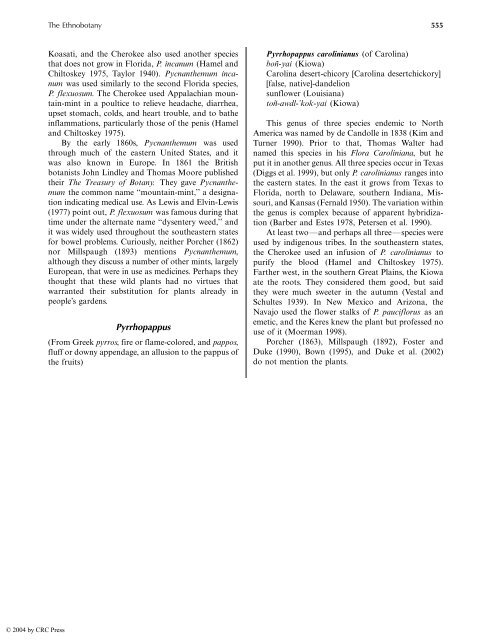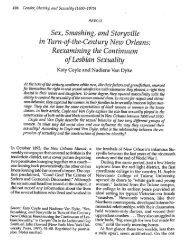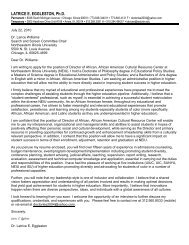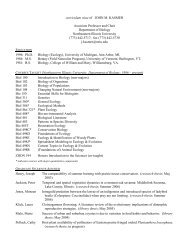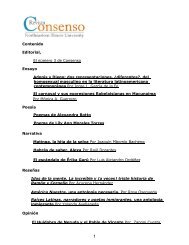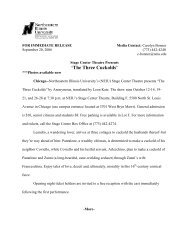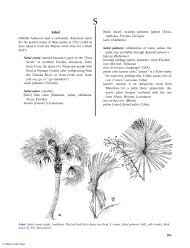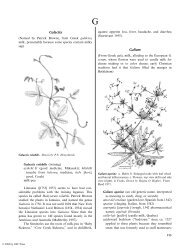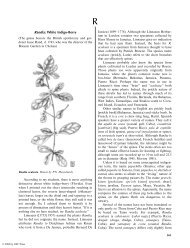Herba Cana - Northeastern Illinois University
Herba Cana - Northeastern Illinois University
Herba Cana - Northeastern Illinois University
Create successful ePaper yourself
Turn your PDF publications into a flip-book with our unique Google optimized e-Paper software.
© 2004 by CRC Press<br />
The Ethnobotany 555<br />
Koasati, and the Cherokee also used another species<br />
that does not grow in Florida, P. incanum (Hamel and<br />
Chiltoskey 1975, Taylor 1940). Pycnanthemum incanum<br />
was used similarly to the second Florida species,<br />
P. flexuosum. The Cherokee used Appalachian mountain-mint<br />
in a poultice to relieve headache, diarrhea,<br />
upset stomach, colds, and heart trouble, and to bathe<br />
inflammations, particularly those of the penis (Hamel<br />
and Chiltoskey 1975).<br />
By the early 1860s, Pycnanthemum was used<br />
through much of the eastern United States, and it<br />
was also known in Europe. In 1861 the British<br />
botanists John Lindley and Thomas Moore published<br />
their The Treasury of Botany. They gave Pycnanthemum<br />
the common name ‘‘mountain-mint,’’ a designation<br />
indicating medical use. As Lewis and Elvin-Lewis<br />
(1977) point out, P. flexuosum was famous during that<br />
time under the alternate name ‘‘dysentery weed,’’ and<br />
it was widely used throughout the southeastern states<br />
for bowel problems. Curiously, neither Porcher (1862)<br />
nor Millspaugh (1893) mentions Pycnanthemum,<br />
although they discuss a number of other mints, largely<br />
European, that were in use as medicines. Perhaps they<br />
thought that these wild plants had no virtues that<br />
warranted their substitution for plants already in<br />
people’s gardens.<br />
Pyrrhopappus<br />
(From Greek pyrros, fire or flame-colored, and pappos,<br />
fluff or downy appendage, an allusion to the pappus of<br />
the fruits)<br />
Pyrrhopappus carolinianus (of Carolina)<br />
boñ-yai (Kiowa)<br />
Carolina desert-chicory [Carolina desertchickory]<br />
[false, native]-dandelion<br />
sunflower (Louisiana)<br />
toñ-awdl-’kok-yai (Kiowa)<br />
This genus of three species endemic to North<br />
America was named by de Candolle in 1838 (Kim and<br />
Turner 1990). Prior to that, Thomas Walter had<br />
named this species in his Flora Caroliniana, but he<br />
put it in another genus. All three species occur in Texas<br />
(Diggs et al. 1999), but only P. carolinianus ranges into<br />
the eastern states. In the east it grows from Texas to<br />
Florida, north to Delaware, southern Indiana, Missouri,<br />
and Kansas (Fernald 1950). The variation within<br />
the genus is complex because of apparent hybridization<br />
(Barber and Estes 1978, Petersen et al. 1990).<br />
At least two*/and perhaps all three*/species were<br />
used by indigenous tribes. In the southeastern states,<br />
the Cherokee used an infusion of P. carolinianus to<br />
purify the blood (Hamel and Chiltoskey 1975).<br />
Farther west, in the southern Great Plains, the Kiowa<br />
ate the roots. They considered them good, but said<br />
they were much sweeter in the autumn (Vestal and<br />
Schultes 1939). In New Mexico and Arizona, the<br />
Navajo used the flower stalks of P. pauciflorus as an<br />
emetic, and the Keres knew the plant but professed no<br />
use of it (Moerman 1998).<br />
Porcher (1863), Millspaugh (1892), Foster and<br />
Duke (1990), Bown (1995), and Duke et al. (2002)<br />
do not mention the plants.


